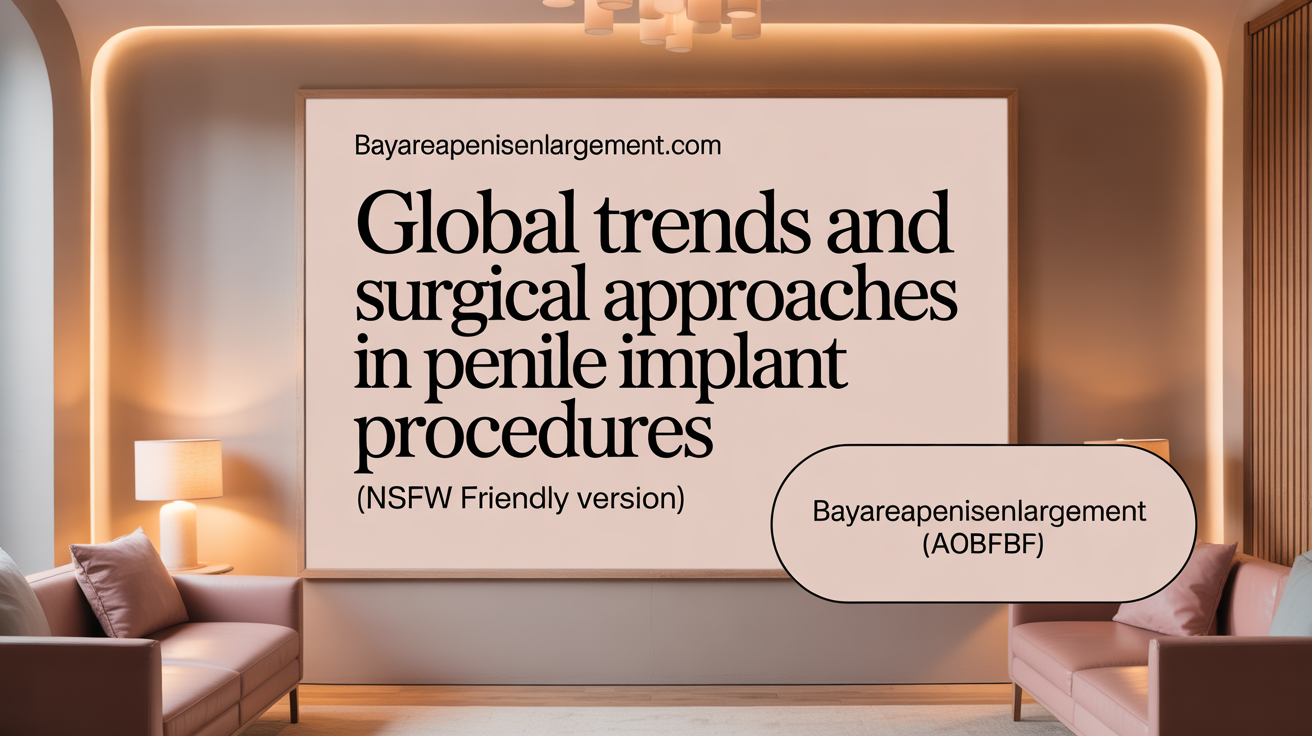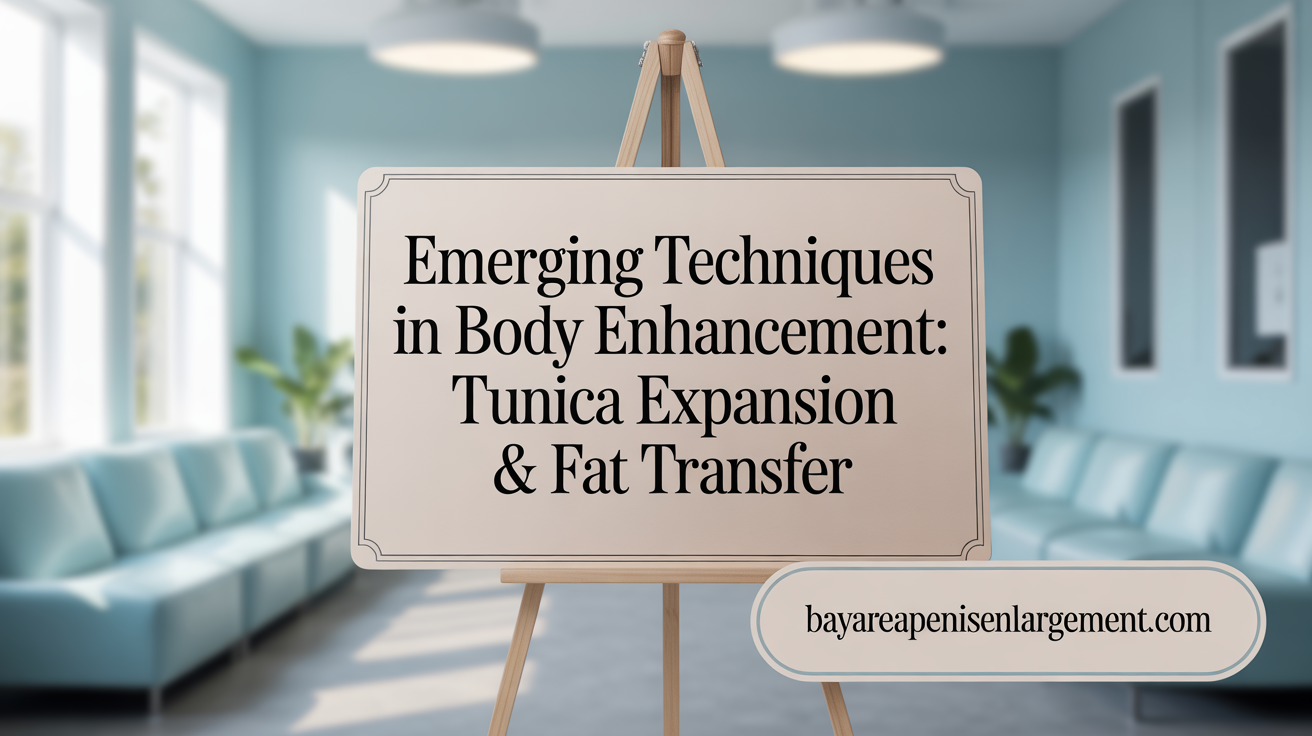Understanding Satisfaction in Penis Enlargement
Penis enlargement remains a highly sought-after procedure, driven by factors including self-confidence, sexual satisfaction, and aesthetic desires. Recent advances in surgical and non-surgical treatments have led to improved techniques and outcomes, but patient satisfaction and safety remain critical concerns. This article delves into clinical data and research findings to present a comprehensive overview of patient satisfaction following various penile enhancement methods, with a particular focus on the Penuma implant, penile prostheses, and injectable fillers. By analyzing outcomes, complications, and patient feedback, we aim to clarify what drives satisfaction and highlight areas requiring further attention.
Patient Satisfaction Levels After Penuma Implant Procedures
What are the patient satisfaction levels after penile enlargement procedures such as the Penuma implant?
Patient satisfaction following Penuma implants and other penile enhancement procedures is generally very high. Several studies and surveys indicate that over 80% of patients are satisfied or very satisfied with their postoperative appearance. In particular, 84.6% of Penuma implant patients report being pleased with how natural their penis looks after surgery, and over 92% feel more confident regarding their penis following the procedure.
In terms of willingness to undergo the surgery again, approximately 75-84% of patients express this desire, underscoring the positive impact on their body image and confidence. Many patients report noticeable increases in flaccid length—averaging about 2.5 cm to 3 cm—and girth increases averaging over 3 cm, which contribute significantly to their satisfaction.
Despite these positive outcomes, some complications can occur. Postoperative issues such as seroma (fluid collection) appear in roughly 12-27% of cases, and about 7% of patients may require revision surgery to address problems like implant malposition. Nevertheless, these rates are relatively low compared to the overall satisfaction levels.
Most patients experience improvements in self-confidence, sexual relationship satisfaction, and appearance. These benefits often outweigh the risks or complications, making penile enhancement procedures a popular choice for men seeking body image improvements. Overall, the data reflects that the majority of patients achieve their desired aesthetic and psychological outcomes from penile implants like Penuma.
Clinical Data on Patient Perceptions of Various Penile Enhancement Methods

What do clinical data and research findings say about patient perceptions and satisfaction following various penile enhancement methods?
Research indicates that most men who undergo penile enhancement procedures are highly satisfied with their outcomes. For inflatable penile prostheses, satisfaction rates can reach as high as 90%, with many men reporting notable improvements in confidence and sexual experience.
The Penuma implant, a silicone sleeve designed for cosmetic enhancement, has shown over 80% satisfaction among patients, with a significant majority feeling pleased with their appearance and self-confidence post-surgery.
Patients value factors such as the natural feel of the implant, maintenance of penile length, and the ability to generate a discreet, functional erection. Interestingly, preoperative expectations—often not perfectly aligned with surgical outcomes—highlight the importance of thorough counseling. Many patients rated the importance of natural appearance and proper function highly in surveys.
Postoperative complications like loss of penile length, pain, and device malfunctions can influence patient perception. However, most patients report that these issues are manageable and would still opt for the surgery again.
Overall, data from multiple studies and meta-analyses reveal that these procedures generally result in high satisfaction levels, with many men experiencing improved self-esteem, body image, and relationship satisfaction.
How important are the natural feel and appearance for patients?
Patients consistently rate natural feel and appearance as top priorities. For instance, those receiving fillers like hyaluronic acid or polylactic acid generally express high satisfaction with the natural look and soft feel, which significantly contributes to their positive perception.
Similarly, men with penile prostheses appreciate the natural sensation during erections, although some report issues like altered sensitivity or mechanical failures that affect perception.
Why is preoperative counseling critical?
Preoperative counseling plays a vital role in setting realistic expectations. Many patients entering surgery without thorough discussions experienced dissatisfaction due to unmet expectations regarding size, appearance, or function.
Proper counseling helps align expectations with achievable results, highlighting the potential for improvements as well as possible complications. This process enhances overall satisfaction and reduces the risk of dissatisfaction postoperatively.
In summary, clinical data show that patient perceptions are generally positive when the procedures are well-explained, and outcomes meet realistic goals. Emphasizing natural feel and appearance, along with comprehensive preoperative counseling, can significantly improve patient experiences with penile enhancement methods.
Outcomes and Effectiveness of Penuma Implant Surgery
What are the outcomes and effectiveness of penile enhancement surgeries, specifically involving Penuma implants?
Penuma implants are soft silicone devices created for cosmetic enhancement of the flaccid penis, primarily targeting men with normal erectile function who are dissatisfied with their penile appearance. These implants have been associated with notable improvements in penile size and patient satisfaction.
Studies indicate that Penuma implantation can increase the flaccid length by approximately 2 to 4 cm, a boost of about 44% to 52%. Girth also shows significant enhancement, with average gains around 3.1 to 3.4 cm or 32% to 37%. Patients often experience improved confidence, with over 80% being satisfied with their post-surgical appearance.
The surgical outcomes extend beyond size. Many patients report feeling more satisfied with how their penis looks and feels, and a substantial portion express willingness to undergo the procedure again, revealing high levels of contentment.
However, like all medical procedures, penile enhancement with Penuma is not without risks. Common postoperative issues include seromas—fluid accumulations that require drainage—as well as infections, implant malposition, and scarring. The rate of complications can be influenced by the surgical approach used.
Different surgical techniques have been studied to optimize outcomes. For instance, the lateral scrotal approach has been associated with lower complication and revision rates (2% and 6%, respectively) compared to the infrapubic method, which reported higher revision (13%) and removal rates (21%).
Overall, penile enhancement using Penuma implants appears effective in achieving desired size increases and high satisfaction levels, with a relatively manageable safety profile. Proper patient selection and surgical approach are crucial to minimize complications and optimize results.
Flaccid and Erect Penile Length Changes After Penuma Implantation
Can the Penuma implant increase erect penile length?
Yes, the Penuma implant can increase erect penile length, but most published data report improvements primarily in the flaccid state. Studies indicate an average increase in flaccid length of about 2.5 cm, which amounts to roughly a 44% increase, and this change is statistically significant (p < 0.01). While these measurements focus on the flaccid penis, some evidence and clinical observations suggest that there may be a corresponding increase in erect length, though specific data on erect measurements remain less detailed.
Patients often seek these procedures for cosmetic enhancement, and there are reports indicating that the overall penile size—both in flaccid and erect states—can be noticeably improved through the use of Penuma. However, the exact increase in erect length varies among individuals. Most studies emphasize the increase in flaccid length more clearly than erect length, and further research is needed to definitively quantify erect length gains.
In summary, while the Penuma implant shows promising results in enlarging the penis when flaccid, the extent to which erect length is increased remains less well defined. Nevertheless, many patients experience perceptible size gains that contribute to improved self-confidence and satisfaction.
Safety Profile and Complication Rates Associated with Penile Implants
What are the safety, efficacy, and complication rates associated with penile implants including the Penuma implant?
Penile implants, such as the FDA-approved Penuma device, have demonstrated effective outcomes in enhancing penile size, with average increases in girth ranging from about 2 to 4 centimeters and length gains of approximately 2.5 to 3 centimeters. These procedures typically lead to high patient satisfaction rates, often exceeding 80%, and improve self-confidence and perceptions of penile appearance.
In terms of safety, the overall complication rate for penile implants remains relatively low. For the Penuma implant, studies report complication rates around 4%, with specific issues including seromas—fluid collections near the surgical site—occurring in about 12-27% of patients, and infections necessitating device removal in approximately 11%. Erosions, which involve the implant gradually wearing through penile tissues, are reported in around 4.8-6.6% of cases. These complications, while problematic, are generally manageable with appropriate surgical intervention.
Revision surgeries, often needed due to malpositioning or other complications, occur in about 7-13% of cases depending on the surgical approach used. Notably, the lateral scrotal approach has been associated with lower revision and removal rates compared to the infrapubic method. Proper surgical technique and patient counseling about potential risks are crucial for optimizing outcomes.
Despite some adverse events, patient satisfaction remains high, with many individuals reporting significant improvements in penile appearance, self-esteem, and sexual confidence. Overall, the safety and efficacy profile of penile implants continues to improve with advances in surgical techniques and device design, underscoring their role as a reliable option for penile augmentation and erectile dysfunction treatment.
Patient Feedback Highlights: Positive and Negative Perspectives on Penuma Implants
What is the general patient feedback including positive and negative reviews on Penuma implants?
Patient experiences with Penuma implants vary widely. Many men report positive effects, such as an increase in penile girth averaging around 2 to 4 cm and a modest lengthening of approximately 2 to 3 centimeters. These physical changes often translate into enhanced self-confidence, improved body image, and higher satisfaction with their penile appearance, with over 80% of patients expressing satisfaction with natural look and self-esteem post-surgery.
However, not all feedback is favorable. Several patients have encountered serious complications. Common adverse events include postoperative pain, swelling, seroma formation, infection, and some cases of device erosion or malposition. A minority of men have required surgical revision or removal of the implant. Some report worsening of curvature, scarring, or disfigurement, which can severely affect psychological well-being. Patient testimonials and independent reviews sometimes highlight dissatisfaction and regret, especially when expectations are not met or complications occur.
While clinical studies often cite high satisfaction rates—ranging from about 75% to over 90%—these figures may not fully reflect the experience of all patients. Independent reports and interviews reveal that adverse effects and dissatisfaction can be more prevalent than officially acknowledged. Men considering Penuma should weigh the potential for physical and psychological benefits against risks of complications.
Overall, the feedback collected suggests that Penuma can be beneficial for some men seeking cosmetic enhancement, but it is associated with notable risks. Careful preoperative counseling and realistic expectations are essential to ensure men make informed decisions about this procedure.
Comparative Satisfaction Between Surgical and Non-Surgical Enhancement Methods
How does patient satisfaction compare between surgical and non-surgical penile enhancement treatments?
Patients' reported satisfaction with penile enhancement methods varies depending on both the type of procedure and their expectations. Surgical options, such as Penuma implants and various reconstructive techniques, tend to yield higher visible increases in penile size—often between 2 to 4 centimeters in girth and notable gains in length. The studies indicate that over 80% of patients are satisfied or very satisfied with their surgical outcomes, with many reporting improved self-confidence and perception of appearance.
However, these procedures carry associated risks. Postoperative complications include seromas, revision surgeries, and, in some cases, implant malposition or removal. For example, the lateral scrotal approach is associated with fewer complications compared to the infrapubic method. Despite positive outcomes, there's an awareness among surgeons that patient satisfaction isn't solely dependent on size gains but also factors such as natural feel and functional appearance.
Non-surgical methods, like hyaluronic acid and polylactic acid injections, offer less invasive options that can increase girth modestly—averaging around 2 to 3 centimeters—with fewer serious risks. Satisfaction rates for these treatments are generally high, often exceeding 75% at follow-up, and long-term safety profiles are favorable, with complications mainly being mild and temporary.
Vacuum devices and other mechanical aids typically do not produce size increases but can improve erectile function and confidence for some users. Nonetheless, they are usually not associated with high satisfaction in size enhancement but may still be valuable for psychological or functional reasons.
Role of Psychological Counseling and Expectations
Psychological counseling is vital in setting realistic expectations. Many men seeking enhancement procedures believe that a larger penis will markedly improve their sexual confidence, but studies reveal that many are within normal size ranges already. Counseling helps align expectations and can reduce unnecessary surgical demand.
When patients understand that non-surgical methods can provide modest improvements and that their satisfaction depends heavily on personal perceptions and mental health, they may choose less invasive options or remain content with their natural size.
Patient Expectations and Outcomes
Ultimately, patient satisfaction hinges on individual goals, understanding of potential risks, and the realistic outcomes of treatment. The higher satisfaction rates reported after surgery are often associated with meaningful size gains but come with a higher risk profile. Conversely, non-surgical treatments are safer and less invasive but tend to produce smaller, sometimes transient, improvements.
In conclusion, choosing between surgical and non-surgical methods should involve careful counseling about the benefits, limitations, and risks associated with each. When expectations are managed properly, both approaches can contribute positively to a patient's confidence and quality of life.
Clinical Outcomes and Patient Satisfaction with Hyaluronic Acid Penile Injections
How much girth increase is observed with HA injections?
Hyaluronic acid (HA) injections have been shown to effectively enlarge the penis' girth. Clinical studies report an average girth increase of approximately 1.41 cm (about 0.55 inches), with improvements often observed within 4 weeks post-treatment. The augmentative effect tends to peak at around 12 weeks and can persist up to 18 months in some cases. The total girth increase before the end of treatment averaged 1.8 cm, highlighting the procedure's effectiveness.
What do patients report about sexual and aesthetic satisfaction?
Patients undergoing HA injections generally report high satisfaction with both the appearance and function of their penis afterward. Satisfaction scores frequently surpass 3.5 out of 4, indicating very positive perceptions of their improved penile size and natural feel. Many express increased confidence in sexual situations, noting enhanced self-esteem and relationship satisfaction. Importantly, the procedure has not been associated with erectile dysfunction or loss of sensitivity, which reassures users about its safety.
What are the complication rates associated with HA injections?
The safety profile of HA penile injections is favorable, with most adverse events being mild and transient. Systemic or serious complications are rare, occurring in less than 1% of cases. Minor local issues include injection site pain, swelling, and inflammation, which typically resolve within days to weeks. Retrospective data involving nearly 300 men reported minor complications such as injection site infections (about 0.42%) and granulomas (about 0.63%), both manageable with appropriate treatment.
How does HA compare with other fillers like PLA and PMA?
Compared to other materials like polylactic acid (PLA) and polymethyl methacrylate (PMA), HA has demonstrated superior or comparable efficacy in increasing girth. Meta-analyses suggest that HA produces a more significant girth increase within the first 12 weeks and maintains desirable results for up to 18 months. Patient satisfaction with HA tends to be higher than with PLA, partly due to its natural feel and lower complication rate. Unlike PMA, which can sometimes cause palpable abnormalities, HA's biocompatibility and resorption profile make it a safer choice.
Overall, clinical evidence supports HA injections as a minimally invasive, effective, and safe modality for penile girth enhancement. Patients report high satisfaction levels, with improvements in both appearance and sexual confidence, alongside a low risk of adverse effects.
Factors Influencing Patient Satisfaction Following Penile Enhancement Surgery

What factors influence patient satisfaction after penile enhancement procedures?
Patient satisfaction after penile enhancement surgeries, including penile implants, is shaped by multiple elements. Foremost among these are the occurrence of complications such as infections, seromas, or mechanical failures. When complications are avoided or minimized, patients tend to report higher satisfaction levels.
The type of implant and surgical approach also play crucial roles. For example, inflatable penile prostheses often yield higher satisfaction compared to malleable devices, primarily due to improved functionality and natural feel. Surgical techniques impact outcomes too; the lateral scrotal approach has been associated with fewer postoperative complications and revision rates than the infrapubic approach.
Patient-specific factors, such as their medical history, influence the overall experience. Men with a history of radical prostatectomy, higher BMI, or conditions like Peyronie’s disease are more prone to lower satisfaction levels.
Preoperative counseling and managing expectations are vital. Ensuring patients understand realistic outcomes and potential risks can lead to a more positive postoperative experience.
Ultimately, a combination of meticulous surgical technique, personalized patient assessment, and thorough preoperative education promotes higher satisfaction rates in penile enhancement procedures.
Trends, Techniques, and Regional Variations in Penile Implant Surgeries

How has the annual number of penile implant surgeries changed over recent years?
The popularity of penile implant surgeries has risen steadily. Between 2006 and 2010, there was an average increase of 8.1% annually in these procedures worldwide. In particular, the number of surgeries spiked in certain years, with a notable 10.1% increase between 2008 and 2009 alone. This growth reflects advances in surgical techniques, increased awareness, and improved patient satisfaction.
Which regions have the highest rates of penile implant procedures?
Most penile implants are performed in the United States, accounting for approximately 86% of cases. Other leading countries include Germany and the United Kingdom. The etiology of erectile dysfunction varies geographically, influencing the number of implants. For example, South Korea reports a high prevalence (52%) of "organic" causes of ED, which often necessitate surgical interventions. Countries like Australia and France see a higher incidence of ED caused by prostatectomy, contributing to their implant rates.
What are the common surgical approaches used?
The penoscrotal approach is the most common, used in about 60-78% of cases globally. It involves an incision at the junction of the penis and scrotum, providing good access for device placement. Alternatively, the lateral scrotal approach has gained attention due to its lower complication rates, including fewer revisions and implant removals. Dr. Valenzuela’s scrotal approach, which does not require circumcision, allows for a less invasive procedure with similar efficacy.
How do the causes of erectile dysfunction influence surgical choices?
The etiology of ED varies by region, affecting surgical planning. In some areas, 'organic' causes like vascular disease or nerve injury from prostate surgeries are prevalent. Such causes often lead to higher implant procedures where other treatments have failed. The choice of surgical approach and implant type tends to adapt to these regional differences, aiming to optimize outcomes and minimize complications.
| Aspect | Details | Regional Variations/Comments |
|---|---|---|
| Annual growth rate | ~8% globally, peaks of over 10% in some years | Driven by tech advances, increasing acceptance |
| Top regions | US (86%), Germany, UK | Strong medical tourism and research centers |
| Main surgical approaches | Penoscrotal (60-78%), lateral scrotal, TEP | Less invasive options preferred in some areas |
| Common ED causes | Organic (vascular, post-prostatectomy) | Regional disease prevalence influences implant demand |
| Factors affecting choices | Surgical technique, patient health, regional practices | Customized approaches to fit local needs |
Understanding these patterns helps inform future developments and regional health policies for penile implant procedures, aiming for safer, more effective, and accessible care for men worldwide.
Innovations in Penile Enlargement: Tunica Expansion and Fat Transfer Techniques

TEP technique overview
The tunica expansion technique (TEP) is an innovative surgical method developed to enhance penile girth and length. This procedure involves small incisions along the tunica albuginea, the outer layer of the corpora cavernosa, to allow controlled expansion of the penile tissue. Dr. Robert Valenzuela, a prominent urologist, has pioneered a scrotal approach to TEP that does not require circumcision. This less invasive procedure uses mobilization of the dartos muscle and Buck’s fascia, with strategic incisions to promote tissue expansion. The goal is to increase size while minimizing trauma.
surgical time and invasiveness
The TEP procedure typically takes about two to three hours, making it relatively efficient. Its minimally invasive approach means smaller incisions and less tissue disruption compared to traditional methods. Since it does not involve extensive dissection or tissue removal, the recovery process tends to be quicker, with most patients able to go home the same day. The technique’s less invasive nature also tends to reduce postoperative pain and swelling.
infection and complication rates
Reported infection rates for TEP are remarkably low, less than 1%, which is significantly lower than many other surgical options. Overall complication rates hover around 4%, including minor issues such as swelling or temporary discomfort. Serious complications are rare, thanks to careful surgical approaches and precise tissue handling. This safety profile makes TEP an appealing choice for men seeking penile enlargement with fewer risks.
effectiveness and recovery
Patients undergoing TEP experience meaningful gains in both length and girth of the penis. The procedure has shown to increase size by a few centimeters, with some reports indicating additional gains over time as tissues adapt and heal. Recovery is typically swift, with most patients resuming normal activities within a few days. Regular follow-up ensures optimal healing and results stability. Patients often report increased confidence and satisfaction post-surgery.
| Aspect | Details | Additional Notes |
|---|---|---|
| Typical surgical duration | 2-3 hours | Efficient procedure time |
| Invasiveness | Minimally invasive | Small incisions, less tissue trauma |
| Infection rate | <1% | Very low, comparable to other minor surgeries |
| Complication rate | ~4% | Mostly minor, manageable issues |
| Estimated size increase | Several centimeters | Gains in both length and girth |
| Recovery time | Days to weeks | Rapid return to daily activities |
This approach, combining tissue expansion techniques with autologous tissue transfer, represents a significant step forward in penile augmentation. It offers promising outcomes with minimal risk, aligning well with patient desires for effective and safe enlargements.
Patient-Reported Outcomes and Feedback Following Penile Prosthesis Implantation

Ease of Use
Patients undergoing penile prosthesis surgery generally report high levels of ease when operating their devices. At 12 months post-operation, about 80% of patients found the prosthesis easy to use, with a significant number feeling confident in manipulating the device for sexual activity.
Natural Sensation Rates
A key concern for many men is how natural their sensation feels after implantation. Approximately 60% of patients reported experiencing a 'very or somewhat natural' sensation during erections one year after the procedure. This indicates that most men feel their sexual experiences remain close to natural, although some dissatisfaction persists.
Sexual Function Outcomes
Most patients experience positive changes in sexual function following penile prosthesis surgery. About 72% reported achieving orgasm during their first sexual encounter after the operation. Additionally, patients often notice improvements in overall sexual satisfaction, with many engaging in intercourse within weeks of device activation.
Common Dissatisfaction Factors
Despite high satisfaction levels, some men face challenges post-surgery. The most common issues include difficulty with orgasm, experienced by approximately 37-39% of patients, and problems with prosthesis deflation, affecting around 32-34%. Loss of spontaneity during sexual activity was also reported by about 26% of men, highlighting areas for potential improvement.
| Outcome Measure | Percentage of Patients | Additional Notes |
|---|---|---|
| Ease of use at 12 months | 80% | Confident operation |
| Natural sensation | 60% | Variability depends on individual cases |
| Achieving orgasm | 72% | During first post-op encounter |
| Dissatisfaction with spontaneity | 26% | Related to device limitations |
Overall, patients generally express satisfaction with penile prostheses, but addressing issues like spontaneity and comfort remains important for enhancing future outcomes.
Synthesis and Future Directions in Penis Enlargement Procedures
Data from numerous studies demonstrate generally high patient satisfaction following penile enlargement procedures, particularly with innovations like the Penuma implant and hyaluronic acid injections. Surgical and non-surgical methods each offer distinct benefits and challenges, with satisfaction strongly influenced by complication rates, surgical technique, and preoperative counseling. Emerging techniques such as tunica expansion and autologous fat grafting provide promising alternatives with favorable recovery profiles. Nevertheless, patient feedback underscores the importance of transparent communication regarding risks and realistic expectations. Future research focusing on long-term outcomes and refined approaches will be essential to optimize both safety and satisfaction in this evolving field.
References
- Outcomes and patient satisfaction after Penuma silicone implant ...
- Under-recognized factors affecting penile implant satisfaction in ...
- Penile enhancement: A comprehensive and current perspective
- Penile prosthesis implantation patients report easy, natural use at 12 ...
- Cosmetic penile enhancement surgery: a 3-year single-centre ...
- Outcomes and Satisfaction after Penile Silicone Implant Surgery
- Offering Patients Innovative Options for Penile Enhancement
- Efficacy and complications of hyaluronic acid and polylactic ... - LWW

